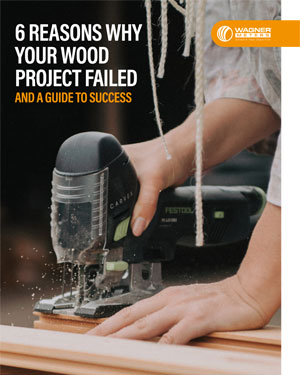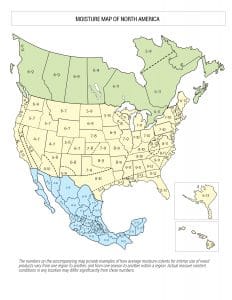EMC: Time, Temperature, Relative Humidity
What Does EMC Stand for and What is EMC?
Equilibrium Moisture Content, or EMC, is the point at which wood is at the same moisture level as its environment so that it no longer releases or absorbs moisture. EMC is a balancing act between the wood and its ambient conditions–raise the relative humidity (RH) and the wood will absorb moisture from the air; lower it and the wood will release moisture into the air.
Why does it matter? Since wood has a hygroscopic (moisture-interactive) relationship with its environment, changes in the wood’s moisture content (MC) will also cause corresponding changes to the wood’s physical dimensions. When wood absorbs moisture, the wood cells expand to accommodate the extra moisture. When it releases moisture, it will decrease in dimension.
If these changes occur after a wood floor has been installed, these dimensional changes may only cause some seasonal gaps, but they may also lead to a host of more problematic symptoms like cupping, crowning, splitting, gaps and more.
The Equation
 Put simply (very simply), the two environmental factors that influence EMC are temperature and the RH of the surrounding air in the space where the wood flooring will be installed. (The exact EMC formula includes a number of variables developed by researching the absorption rate of non-living wood and EMC tables or EMC calculators, like the free Wagner Meters Wood App. Take these variables into account when calculating EMC.)
Put simply (very simply), the two environmental factors that influence EMC are temperature and the RH of the surrounding air in the space where the wood flooring will be installed. (The exact EMC formula includes a number of variables developed by researching the absorption rate of non-living wood and EMC tables or EMC calculators, like the free Wagner Meters Wood App. Take these variables into account when calculating EMC.)
There are a number of recommendations for each job site, but always follow the manufacturer’s guidelines for proper acclimation procedures:
– The place where the flooring will be installed should have adequate ventilation, and HVAC systems and any humidifiers that are part of the design should be operational for 5-7 days prior to delivering the wood flooring. All other materials, like concrete or plaster, should also be dry before bringing the wood flooring on site.
– Your flooring must be exposed to these conditions in order to acclimate. Open the packaging and, if possible, stack the flooring boards with thin strips between them to allow air circulation to all the floorboards.
– As you stack, measure the wood flooring with a wood moisture meter (we recommend pinless moisture meters for damage-free accuracy) and determine the EMC for your area and season using an EMC table or calculator.
It is also often a good idea to have a thermo-hygrometer on site to establish that the site conditions are also stable.
RH
Ambient RH, or the water vapor in the air surrounding the flooring, actually has the greatest impact on wood MC. As was mentioned, wood is a hygroscopic material that readily absorbs and releases moisture. Higher RH means more water vapor to be absorbed by the wood until it reaches a stable level with the surrounding air.
However, if the air has a lower RH than the wood’s MC, the wood will release moisture into the air. It’s helpful to know which way your wood’s MC will be moving in order to establish EMC.
Temperature
Temperature is significant to wood MC mostly because of how it impacts the RH of air. If lowering or raising the temperature significantly impacts the RH on the job site, reaching EMC will take much longer to achieve.

Free Download – 6 Reasons Your Wood Project Failed
Put Time on Your Side
From this point on, the key to successfully adapting wood flooring to each job site is actually time. Why?

If any of these moisture changes happen too quickly, wood may warp, split, twist or buckle as the different faces of the wood absorb moisture at varying rates. For example, end grains will absorb moisture more quickly because the wood has been cut across the wood cells, creating a structure that looks like bundled drinking straws.
While some manufacturers will recommend a number of days to reach EMC, the only way to be completely confident the flooring has reached EMC is with an accurate wood moisture meter. Our damage-free wood moisture meters offer a simple, easy-to-use accuracy that does not mar the flooring.
With specific gravity settings for both domestic and exotic kinds of wood, our pinless wood moisture meters have the ability to “scan” many board feet quickly for instant verification of the wood’s progress towards EMC. Once the wood’s MC has stabilized, you can install with complete confidence that the wood flooring will remain durable and beautiful for years to come.
As wood moves towards EMC on any new site, temperature and RH will determine the amount of moisture that must be absorbed or released, but time becomes the critical component between finding the right moisture balance and having moisture-related flooring problems.
Tony Morgan is a senior technician for Wagner Meters, where he serves on a team for product testing, development, and also customer service and training for moisture measurement products. Along with 19 years field experience for a number of electronics companies, Tony holds a B.A. in Management and his AAS in Electronics Technology.
Related Posts via Taxonomies
Last updated on November 21st, 2022




recently moved into a new home. Our new floors are now experiencing cupping. Assuming instalation was done properly I am wondering if certain paint used on trim can have an effect on the wood. The trim is painted with a semi gloss and seems not yet to be throughly hardened. Not sticky to the touch but when running my hand down the door trim in some places there is a slight pull. It has been well past 6 months.
Hi Karen. Here is the most likely cause and cure as quoted from a wood floor technical publication.
Cupping occurs across the width of the individual pieces of flooring. The edges are high and the center is lower. It generally develops gradually.
Cause:
• A moisture differential within individual pieces of flooring, usually excessive moisture on the underside of the flooring. More subtle cupping can be caused by lack of proper acclimation (this is generally permanent cupping).
Potential sources of excessive moisture include:
– Building leaks
– Poor drainage
– Plumbing leaks or overflows
– Leaks from dishwashers or refrigerator icemaking units
-Wet or damp basements/crawlspaces
-Concrete subfloors that have not cured
-Plywood subfloors with excessive moisture
-Poor or no ventilation
-HVAC system not operating.
• Flooring also may cup when a wood floor experiences conditions that cause rapid drying on the surface. This condition occurs with gaps as the flooring shrinks.
Cure:
Never attempt to repair a cupped floor until all of the sources of excessive moisture have been located and eliminated. This can be verified only with a moisture meter that takes readings of the underlying subfloor.
As long as the wood is not permanently deformed or damaged, the flooring will return to its original shape and size when the excessive moisture is removed. This may take weeks, months, or even an entire heating season.
Attempting to sand a cupped floor while it is still too wet may cause subsequent crowning when the floor dries. Flooring that does not return to its original shape, even after completing an entire heating season, probably is permanently deformed. (Taking moisture readings at different levels in the wood flooring also can help determine this—if there is a gradient of 1 percent or more between the top and bottom of the boards, they probably are not done drying.) If the boards are permanently deformed, the cupped edges may be sanded off.
For floors that have cupped due to drying, relative humidity should be increased. Relative humidity below 20 percent is considered very dry for wood flooring, and it is suggested that humidification be provided under such conditions.